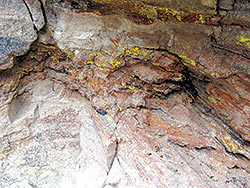Geology HAPPENINGS September 2018 |
||||||||||||||
| The Geology of the Uranium Capital of the World by Allyson Mathis |
||||||||||||||
Today, Moab is known worldwide for its two national parks, for Dead Horse Point State Park, and for the surrounding public land with its superlative scenery. People also treasure these lands for their ample opportunities for exploration while hiking, mountain biking, four-wheel-driving, rafting and climbing and even through a simple scenic drive. Yet, before Moab gained its current reputation as one of the most scenic areas in the United States and as a mecca for a variety of outdoor pursuits, Moab was known across the country for the occurrence of a single element found in deposits in some of the rocks that make up the canyons and cliffs in the surrounding countryside: uranium.
le most important uranium discovery in the United States. Uranium-bearing ore had been known from the Colorado Plateau since approximately 1900 when it was mined on a small scale to pigment ceramics and porcelain and then for the production of radium after Marie Curie discovered that element. Later these ores were mined for vanadium, which hardened steel, which was important during World War I.
Carnotite is just one of many uranium minerals found on the Colorado Plateau. Most of these minerals are brightly-colored and have very complex chemical formulas, consisting of some combination of uranium with potassium or calcium, oxygen, hydroxide, carbonate, phosphate or sulfate, and sometimes containing vanadium, copper or arsenic. A mineral called uraninite, also called pitchblende for its earthy black color, makes up the richest ores, as it is almost pure uranium oxide. Until Charlie Steen’s discovery, pitchblende wasn’t known in Utah. Steen didn’t use a Geiger counter to locate possible uranium deposits like other prospectors. In fact, he didn’t own one, and this along with his search for uranium in areas not considered ore-bearing by the Atomic Energy Commission caused his effort to be termed “Steen’s folly.” Steen staked claims based on the characteristics of regional geology, and prospected like a wildcatter explored for oil. Steen encountered unusual black rocks while drilling his claims in search of carnotite deposits deep below ground level. Steen set aside these black rocks and continued drilling, thinking that carnotite deposits were deeper but his drilling rig broke a few feet short of his goal. Dejected, he grabbed the strange black samples before heading back to town
to see if he could repair his drill, thinking that his dream of striking it rich was over. When he pulled in to a gas station, he joked with the owner that he had some samples that would set off his Geiger counter, still not realizing that he had drilled through a thick lens of high-grade ore. It wasn’t until the counter’s needle jumped that he realized that he had found pitchblende, a mineral that he had never previously seen. Soon thereafter, Steen began mining, built himself a mansion on a hill (now the Sunset Grill where diners can view mementoes from Steen’s life and Moab’s uranium heyday), and became a national celebrity. The uranium was deposited by circulating groundwater at some point after the rock layers were deposited. The ultimate source of the uranium is not definitely known, but it likely was from volcanic ash that was deposited across Utah. Uranium is present in minute amount in volcanic ash, and it can be easily leached by circulating groundwater. Uranium is highly soluble in water, but will precipitate out of solution when it encounters a reducing environment (e.g., one low in oxygen), such as that occurs in the presence of the organic debris in the Chinle or Morrison sands. In fact, some of the earliest ores discovered in Utah were petrified wood or dinosaur bones where uranium minerals replaced organic material, and both petrified wood and dinosaur fossils may be radioactive.
|

_(14926263573).jpg)




